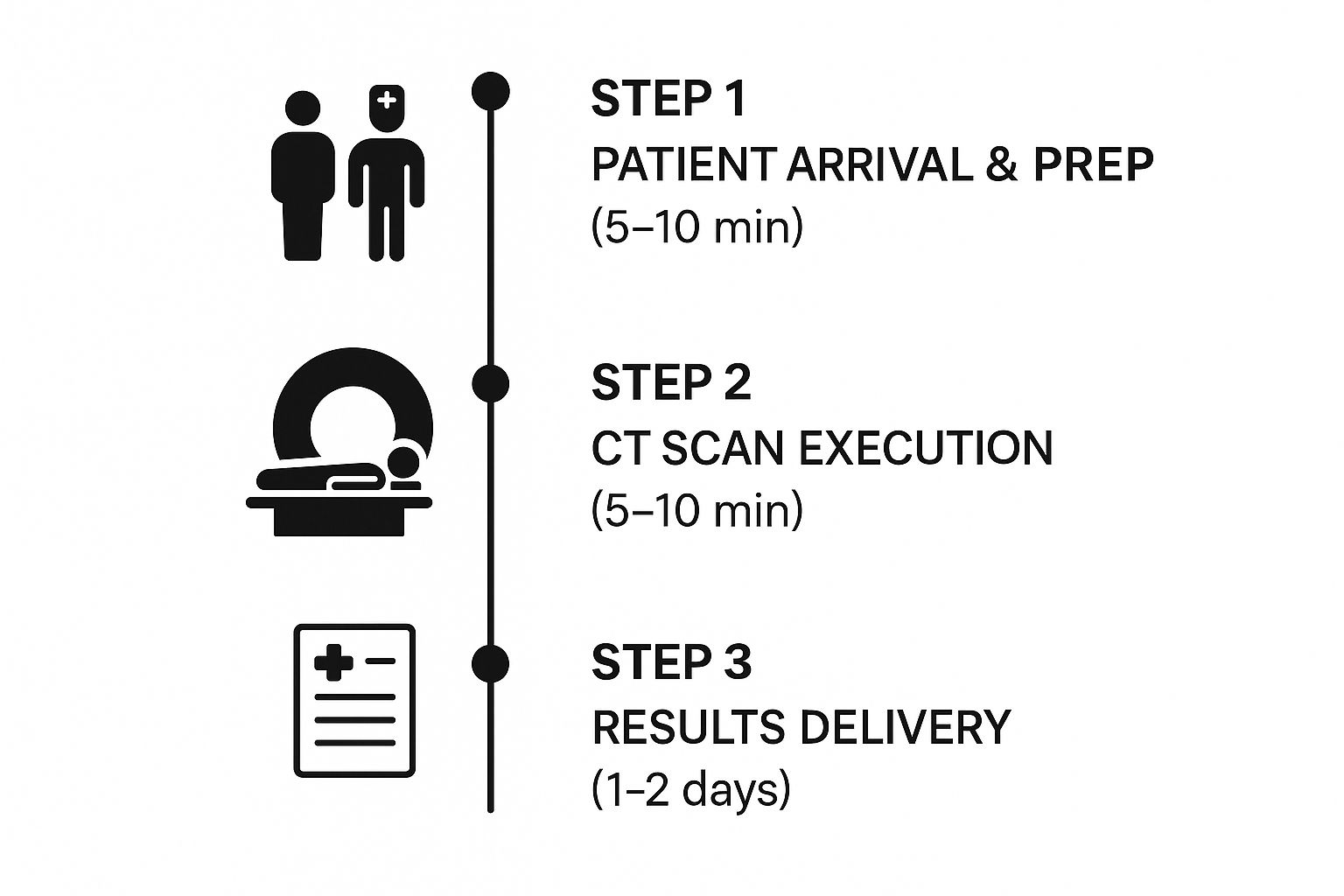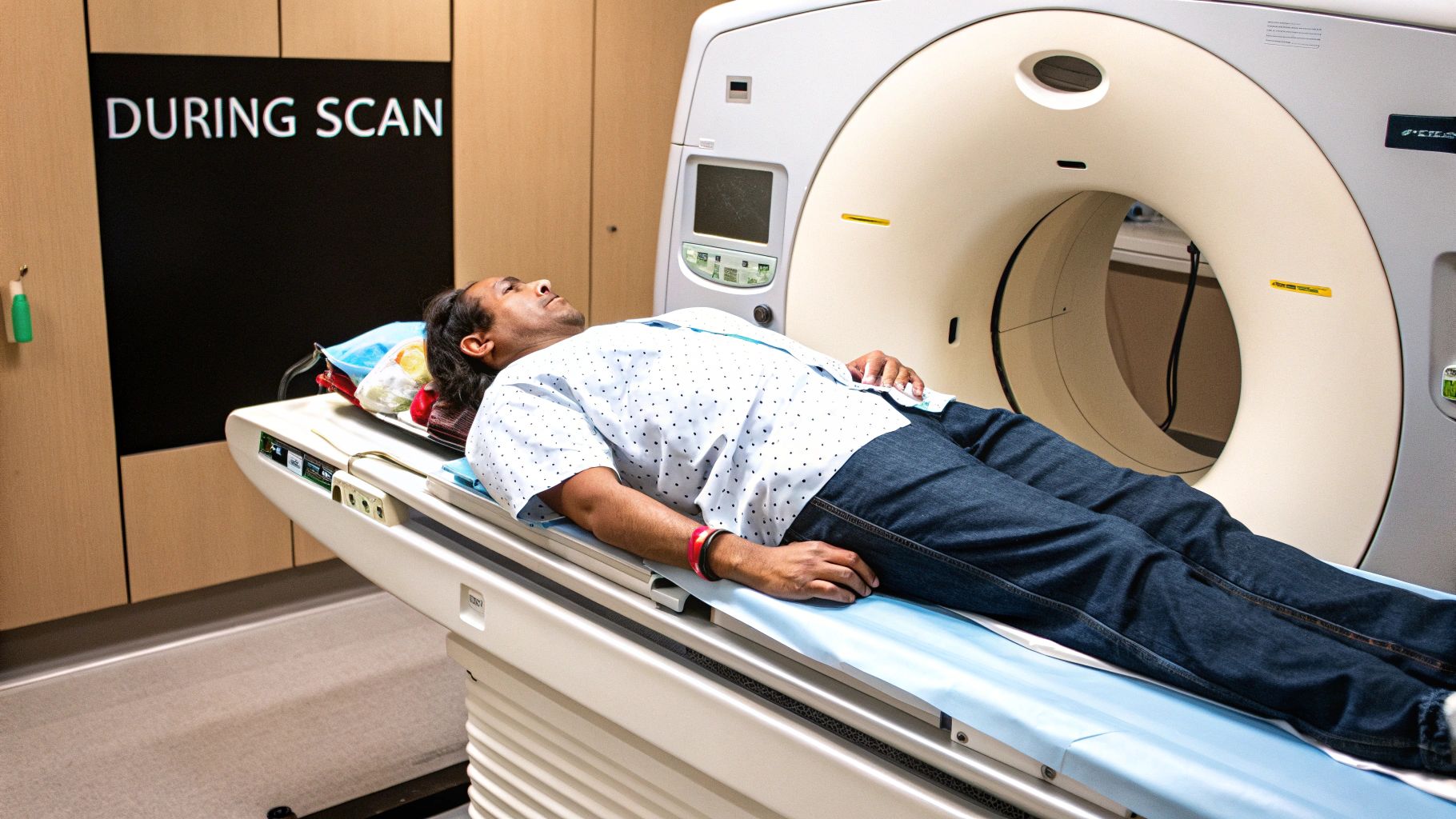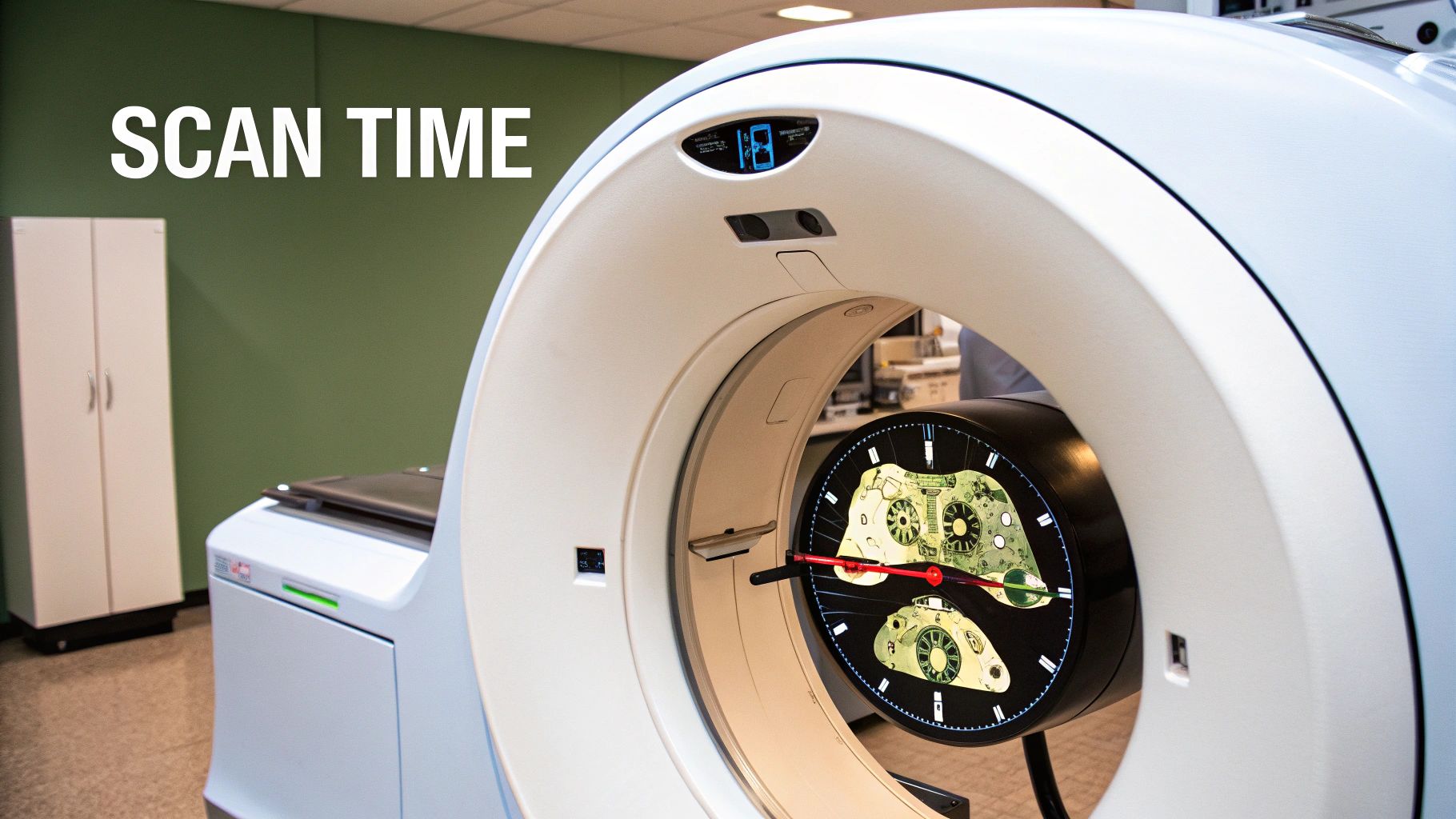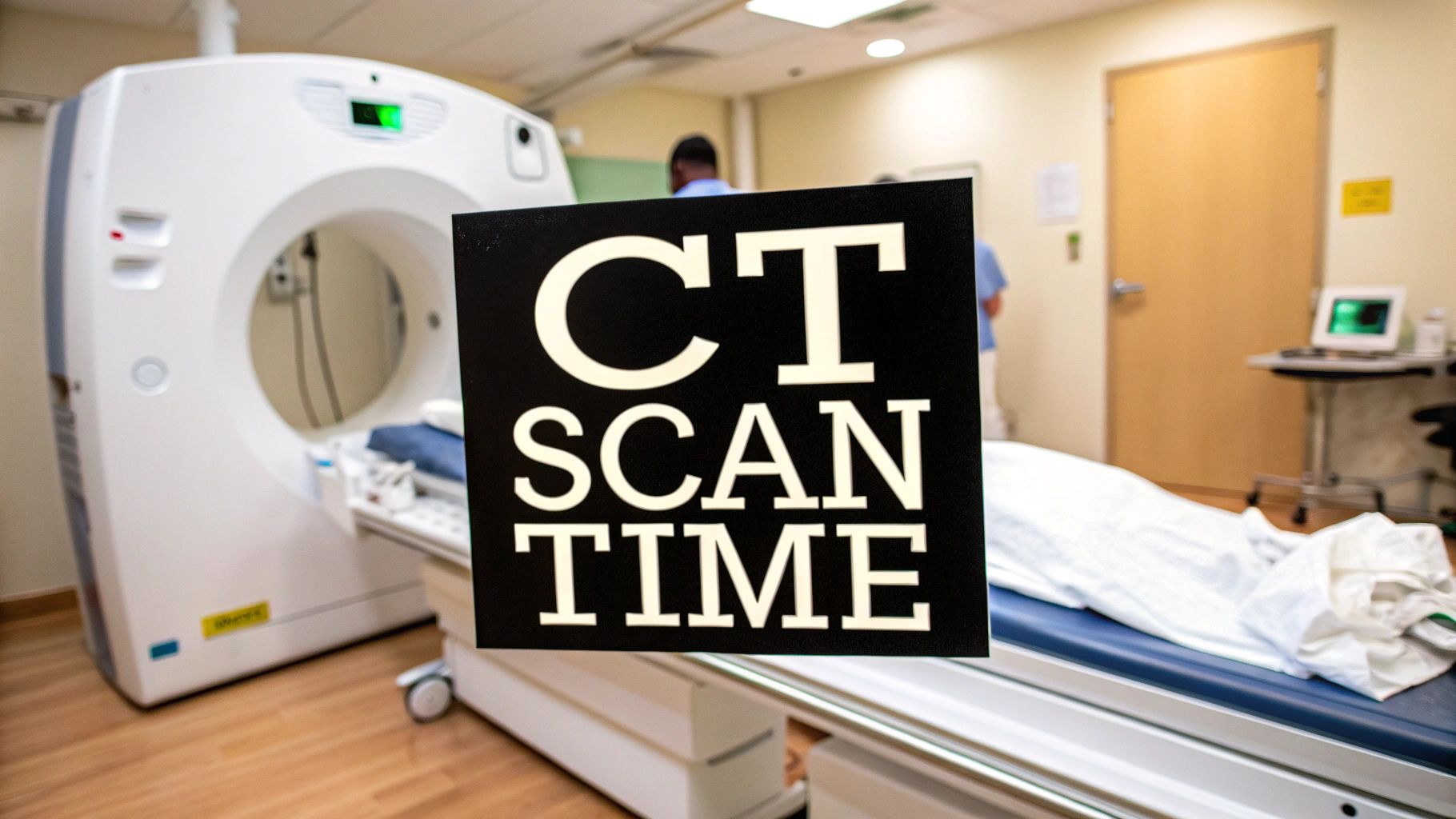.webp)
One of the first questions on most people’s minds is, "how long is this actually going to take?" It’s a fair question, and the answer is often a pleasant surprise.
The CT scan itself—the part where the machine is actually taking the images—is incredibly quick. We’re talking just a few minutes. But your total time at the clinic, from walking in to walking out, will be a bit longer, usually somewhere between 30 and 60 minutes.
This extra time is all about proper preparation and making sure everything is done safely and correctly.
Think of it like a professional photoshoot. The click of the shutter is instant, but most of the time is spent on getting the lighting right, positioning the subject, and checking the shots afterwards. A CT scan is very similar. The bulk of your appointment is dedicated to these essential prep and post-scan steps.
Here’s a rough breakdown of what a standard appointment looks like from start to finish.
As you can see, the scan is just one small part of the overall process. The preparation phase is crucial for ensuring we get the highest quality images, and the post-scan checks are there for your safety, especially if a contrast dye was used.

This entire process ensures that when the radiologist sits down to analyse your results, they have the clearest, most accurate pictures to work with. The time spent in preparation directly translates to the quality of the diagnosis.

It’s a really common question: if the scan only takes a few minutes, why is my appointment an hour or even longer? It’s a fair point, but the answer is all about the crucial steps that happen before and after the scan itself—steps that are there to keep you safe and ensure the images are as clear as possible.
Your appointment really starts the moment you walk through the door. You’ll check in at the desk, confirm your details, and sort out any last-minute paperwork. After that, you’ll likely be asked to change into a hospital gown and remove anything metallic like jewellery, watches, or belts, as these can disrupt the scanner.
The biggest factor that can stretch out your appointment time is whether you need contrast material. This is a special dye designed to make certain parts of your body—like organs, blood vessels, or tissues—stand out in sharp detail on the final images.
If your scan needs it, the dye can be given in a couple of ways:
This preparation phase is the main reason why the total appointment time is so much longer than the scan itself.
Once the scan is over, there are still a couple of things to do. If you had an IV line, the technologist will remove it. You’ll also be asked to wait for a short while—usually 10 to 15 minutes—just to make sure you don’t have any reaction to the contrast dye before you’re given the all-clear to head home.
In the UK's NHS system, the actual time you spend inside the scanner is surprisingly fast, often just 5 to 20 minutes. The full appointment slot, however, is carefully planned to include all these essential prep and follow-up stages.
While you're looking into your health, you might also be interested in other minor procedures, such as getting more information on skin tag removal.

While most CT scan appointments run like clockwork, a few key things can change how long you’re with us. No two scans are ever exactly the same because every patient’s clinical picture is unique. The length of your visit really comes down to what information your doctor needs to find.
Asking how long a CT scan takes is a bit like asking how long it takes to cook a meal – it all depends on the recipe. A quick scan of the head is one thing, but a detailed look at the abdomen, covering multiple organs and intricate structures, is another matter entirely.
Probably the single biggest variable is whether or not your scan requires a contrast material. This is a special dye we use to make certain tissues, organs, or blood vessels stand out clearly on the final images, but it does add a few extra steps to your appointment.
Contrast dye can be given in a couple of different ways, and each has its own timeline. Knowing which method you’ll need can help you plan your day much more effectively.
The table below breaks down the different ways we use contrast material and how each one can impact the total time you'll spend at the clinic for your scan.
The waiting period for oral contrast is crucial for getting clear, accurate images of your digestive system, so while it adds time, it's a vital part of the process.
This waiting period is non-negotiable and essential for diagnostic accuracy. Rushing this step could lead to blurry images, which might mean we’d have to repeat the entire scan.
Beyond the area we’re scanning and the use of contrast, a couple of other things can affect your appointment length. Every hospital has slightly different protocols, so extra paperwork or checks might add a few minutes to your visit.
Your cooperation is also key. The scanner needs you to stay perfectly still to capture sharp, focused images. This can be tricky, especially for young children or patients who are in pain.
For certain scans, like those of the pelvic region, patient comfort and stillness are particularly important. It's helpful to be aware of conditions that might make this challenging, and we'll always take the time needed to make sure you're comfortable. You can learn more about specific pelvic health topics by reading our guide on managing vaginismus. We’ll always allow extra time to ensure you can hold the required position without discomfort.
Knowing what’s involved before you arrive and after you leave can make the entire CT scan experience feel much less daunting. Your preparation actually starts at home, with a few simple instructions that make a huge difference to the quality of your scan.
You’ll likely be asked to avoid eating or drinking for a few hours before your appointment, particularly if your scan involves a contrast dye. It’s also a good idea to wear loose, comfortable clothing without any metal zips, buttons, or underwiring. Most importantly, always let the radiographer know about any allergies, existing medical conditions, or medications you’re taking.
If you tend to feel anxious about medical procedures, a few simple calming techniques can really help. You can find some useful breathing exercises for anxiety relief that you can do quietly while you wait, or even during the scan itself.
Once the imaging is finished, the post-scan care is usually very straightforward. If you received contrast dye, the most important thing is to drink plenty of water for the rest of the day. This simply helps your kidneys flush the material out of your system.
After that, you’re typically free to go home and get back to your normal routine straight away. For many people, it's a relief to know there’s no real downtime required.
It’s crucial to understand that getting your results is a separate process from the scan itself. The radiographer operating the machine can't give you immediate answers; a specialist radiologist has to carefully analyse the images and compile a detailed report for your doctor first.
This reporting stage is often what takes the most time. While the scan itself is quick, NHS England data shows that delays can happen during the analysis phase. In fact, over 3% of complex scan reports were delayed beyond 28 days, a situation that affected thousands of patients and highlights that the wait for results is its own timeline. You can find out more about these diagnostic wait times by exploring the full report on scan delays in the UK.
For those interested in innovative treatments that may follow a diagnosis, our clinic also provides information on options like PRP Therapy.

When you ask how long a CT scan takes, there are really two very different answers. There's the time you spend in the hospital for the scan itself, and then there's the long road from your GP referral to actually getting that appointment. For most people in the UK, the real delay isn’t the procedure—it’s the wait to get one.
The physical scan is usually over in a matter of minutes. But the journey to get there can stretch into weeks, or even months. This is what people typically mean when they talk about "waiting for a CT scan," and how long you'll be waiting depends hugely on how urgent your case is and where you live.
Officially, the NHS has an operational standard that aims for less than 1% of patients to wait longer than six weeks for a diagnostic test. That's the goal. The reality on the ground, however, often tells a different story.
Recent data from England shows that 8.1% of patients referred for a CT scan waited six weeks or more. That’s more than one in every twelve people facing a significant delay before they even set foot in the hospital.
This figure really highlights where the bottleneck is—it's in the waiting list, not the scanner room. To get a better grasp of the broader challenges in healthcare scheduling, it's worth looking into general strategies for reducing patient wait time being explored across the medical field.
Even after you understand the process, it’s completely normal to have a few last-minute questions popping into your head. Getting them answered beforehand can make all the difference, helping you walk into your appointment feeling calm and prepared.
Here are a few of the things we get asked most often.
One of the first things people worry about is comfort. A CT scanner does make a quiet whirring or buzzing sound while it’s working, but it’s not loud like an MRI machine. The scan itself is completely painless.
The only time you might feel a slight discomfort is if you need contrast dye. That involves an IV injection, which feels like a quick, sharp prick—just like having a blood test. Other than that, you won’t feel a thing as the scanner captures the images.
Yes, almost always. As long as your scan didn’t involve any sedation, you’re usually free to drive home and get straight back to your day. There’s no recovery time needed.
If contrast dye was used, we’ll just advise you to drink plenty of water to help your body flush it out. The only time you’d need a driver is in the very rare case that a sedative was required for the scan.
A CT scanner is shaped like a large, open ring—often described as a doughnut—not an enclosed tunnel like some older MRI machines. This open design means most people do not feel claustrophobic during the procedure.
If you have a serious fear of enclosed spaces, it’s always a good idea to chat with your doctor about it beforehand. They can offer reassurance and make sure you feel as comfortable as possible on the day.
To help reduce waiting times, the UK has been expanding its network of community diagnostic centres (CDCs) for out-of-hours scanning. There are now over 100 of these centres in England, often running 12 hours a day, 7 days a week. This extra capacity has been a huge help for the NHS in meeting crucial diagnostic targets, especially for cancer care. You can learn more about these out-of-hours diagnostic services and how they’re improving patient access.
At The Vesey, we put clear communication and your comfort first. If there’s anything else on your mind or you’d like to book an appointment, please visit us at https://www.thevesey.co.uk.

